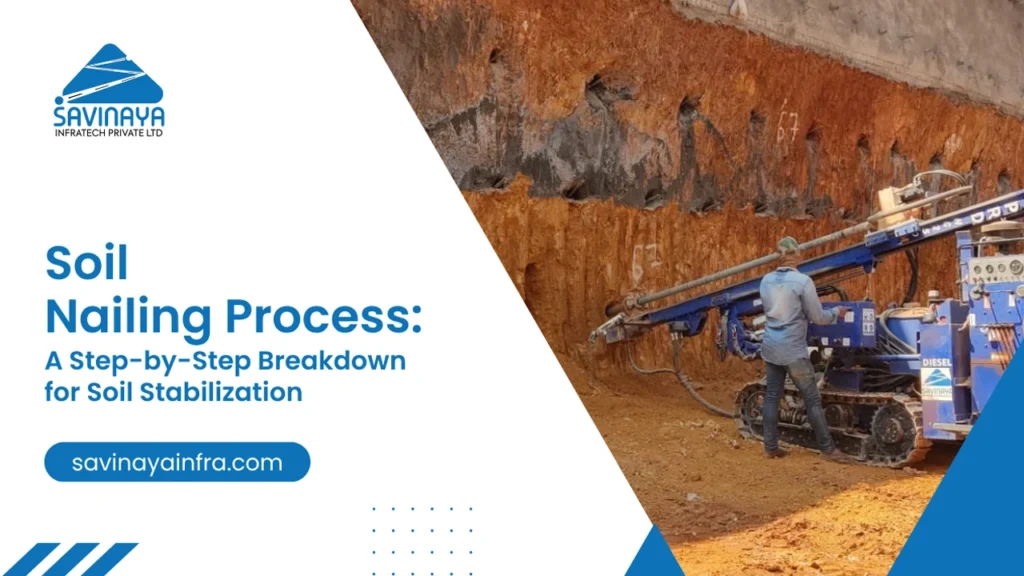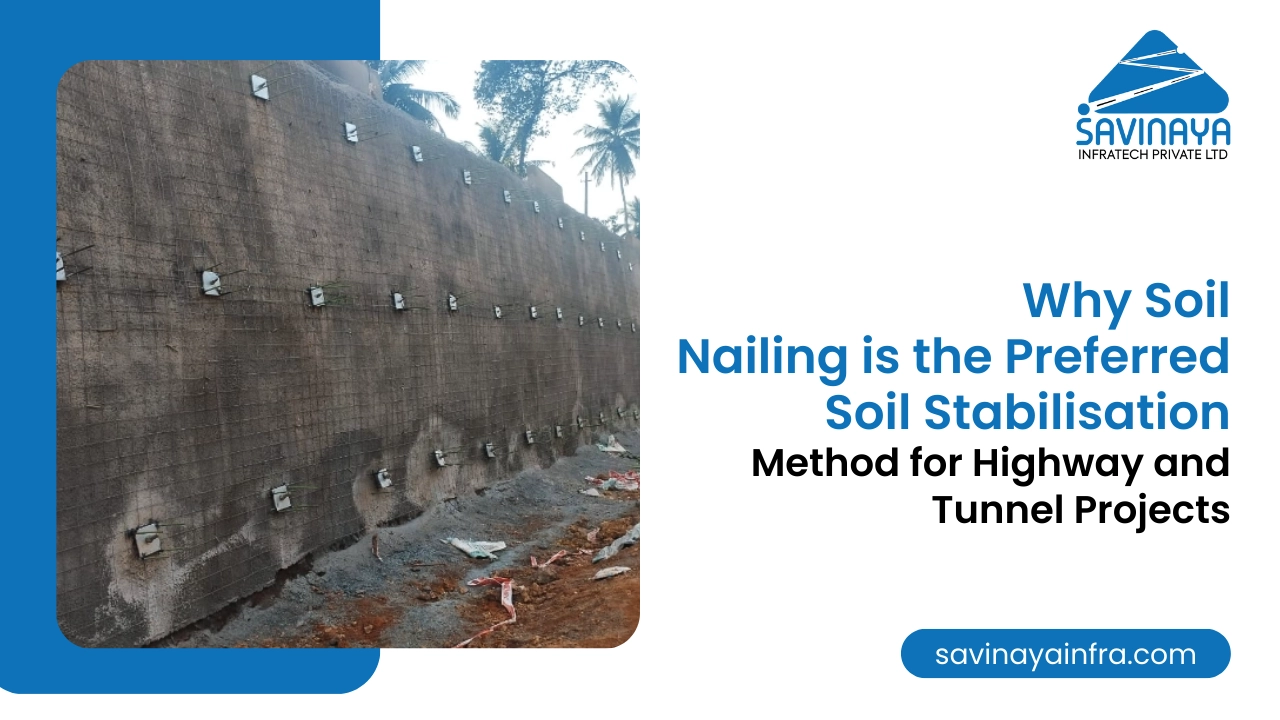The ground beneath our feet holds more than just soil — it carries the weight of everything we build. From roads and tunnels to high-rise buildings and underground basements, the strength and reliability of a construction project often depend on how stable the soil is. This is where soil stabilization techniques become incredibly valuable. Among the many solutions used to reinforce the earth, the soil nailing process has stood out as a smart and efficient option.
Soil nailing is not a new trend, but its role in modern infrastructure has grown rapidly due to its adaptability and cost savings. Unlike bulky retaining systems, the soil nailing method doesn’t require heavy construction or massive structural support. Instead, it works by strengthening the natural soil using slender steel rods known as soil nails that are inserted into pre-drilled holes.
These nails create an internal framework, anchoring the soil and improving its ability to support nearby structures. This approach forms the backbone of many soil nailing systems in use today. Let’s take a closer look at what is soil nailing process and explore why this technique is reshaping the way we stabilize the ground beneath us.
Table of Contents
Advantages of Soil Nailing for Stabilization
There are many reasons why the soil nailing technique has become one of the preferred solutions for geotechnical and infrastructure projects. Below are the key advantages of soil nailing, especially when compared to traditional retaining methods:
- Flexibility: It adapts well to different soil conditions, making it suitable for a wide range of projects.
- Speed: The soil nailing construction process is relatively quick, helping contractors stay on schedule.
- Cost-Effective: Since it uses fewer materials and doesn’t require bulky support systems, it reduces overall construction costs.
- Environmentally Friendly: It works with the existing landscape, minimizing land disturbance.
- Proven Performance: The method has a solid track record in projects like retaining walls, road cuts, underground excavations, and slope protection.
Many developers also prefer soil nailing systems because they offer long-term stability with minimal maintenance. The combination of nails, grouting, and surface facing creates a strong internal support system that can handle heavy loads and dynamic pressures over time. In cases where retaining walls are needed, a soil nailing retaining wall provides a durable, space-saving alternative to conventional concrete walls.
Bonus: Want a quick visual recap of this blog ? Check our web story on Top 7 Soil Nailing Process Boosts Slope Stability.
A Step-by-Step Soil Nailing Process for Soil Stabilization
To fully understand the strength and reliability of this method, it’s helpful to look at the complete soil nailing construction process. Each phase contributes to the overall stability of the structure and ensures safety throughout the project lifecycle.
1. Site Analysis and Engineering Design
Every successful project begins with a detailed site investigation. Engineers examine the soil profile, slope geometry, water table, and load conditions. Based on this data, they develop a tailored plan for the soil nailing procedure, including nail length, diameter, spacing, and facing type.
2. Staged Excavation
The excavation is carried out in small, controlled stages. After each layer of soil is removed, it is immediately supported with soil nails. This staged method reduces the chance of sudden ground movement, making it safer and more efficient.
3. Drilling Nail Holes
Specialized equipment is used to drill holes at precise angles and depths based on the design. This step sets the foundation for the entire soil nail wall installation process, and precision is critical to ensure long-term performance.
4. Installing the Soil Nails
Steel bars, often ribbed or threaded, are inserted into the drilled holes. These bars become the structural anchors that provide internal reinforcement to the soil. This step is the core of the soil nailing construction method.
5. Grouting
Grout is pumped into the holes to fill the space between the soil and the steel bars. This creates a strong bond, locks the nails in place, and helps resist any future ground movement.
6. Applying Surface Facing
To prevent soil erosion and protect the exposed soil surface, a layer of shotcrete or wire mesh is applied. This surface covering also helps distribute the pressure evenly across the slope or wall, completing the soil nailing retaining wall system.
7. Testing and Monitoring
Finally, engineers carry out load tests and visual inspections to verify the strength and effectiveness of the installation. This step ensures that the entire soil nail installation process meets safety and design standards.
You may also read: How Soil Nailing is Different from Ground Anchors?
How Savinaya Infratech Can Help in Soil Nailing Projects?
When it comes to complex soil stabilization techniques, having the right partner makes all the difference. Savinaya Infratech brings a combination of technical knowledge, real-world experience, and advanced equipment to every soil nailing construction project.
We understand that no two sites are the same, and that’s why our team provides customized solutions based on detailed site analysis. From initial design to final monitoring, our engineers ensure every stage of the soil nailing procedure is executed with accuracy and care.
Here’s how we stand out:
- Expert Design and Engineering: Our team designs reliable soil nailing systems suited to your unique site conditions.
- On-Site Execution: With skilled crews and modern tools, we handle every aspect of soil nail wall installation efficiently.
- Quality Control: We perform strict testing and monitoring at each step to ensure safety and performance.
- Comprehensive Service: Whether it’s a slope protection project or a basement excavation, our soil nailing services cover it all.
If you’re searching for a trusted soil nailing company, look no further. Savinaya Infratech delivers not just engineering — we deliver confidence from the ground up.
Final Thoughts
The soil nailing method has transformed how engineers approach slope and wall stabilization. Instead of replacing weak soil with massive retaining structures, this technique turns the existing earth into a strong, supportive foundation. It’s a smarter, cleaner, and faster way to improve ground stability — and its effectiveness is backed by decades of successful application.
Whether you’re dealing with a sloping hill next to a highway or digging deep into urban ground for a building foundation, the soil nailing process offers a powerful and proven solution. By combining engineering expertise with the right tools and techniques, you can build safely, efficiently, and with confidence.
And with a partner like Savinaya Infratech, you’re not just stabilizing soil — you’re laying the groundwork for long-term success.
Get Expert Soil Nailing Solutions Today!
Ready to take the next step in securing your construction site? Let Savinaya Infratech bring its expertise to your project with end-to-end soil nailing services. From design to execution, we make sure your project stays strong — from the ground up. Get in touch.


